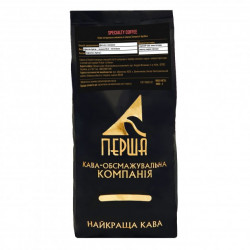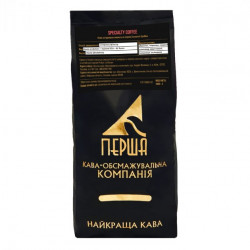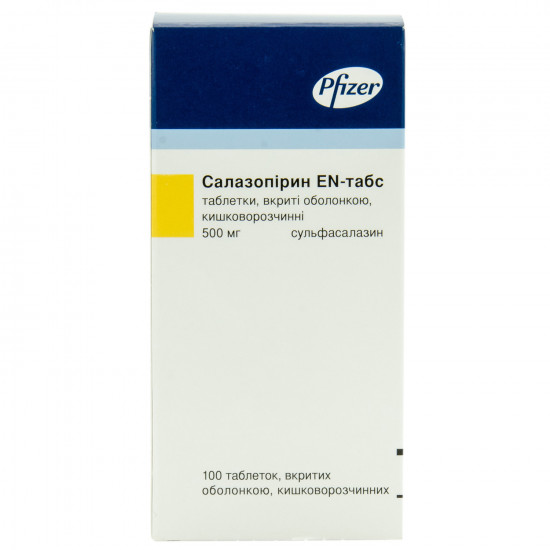
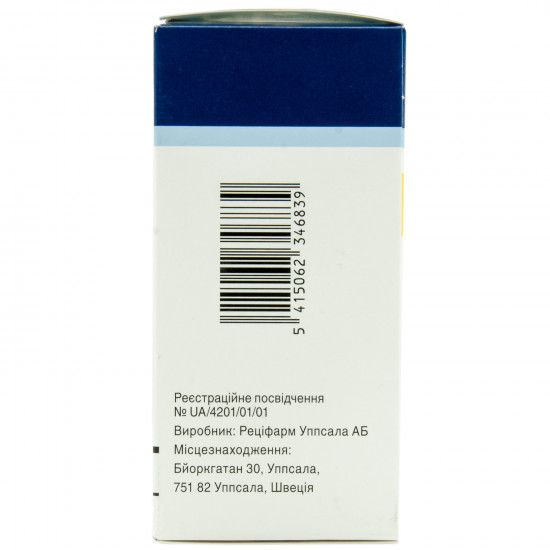
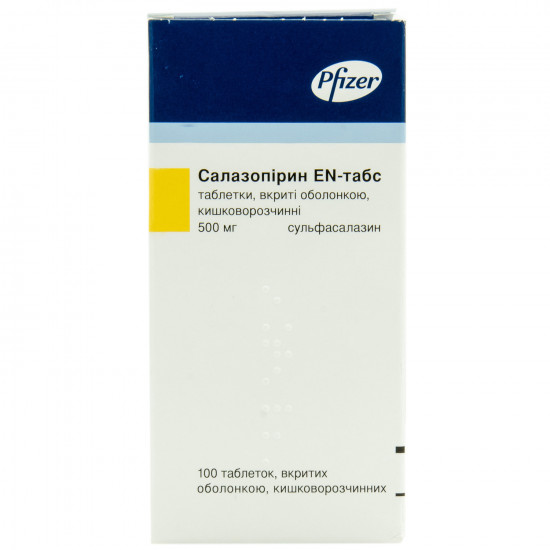
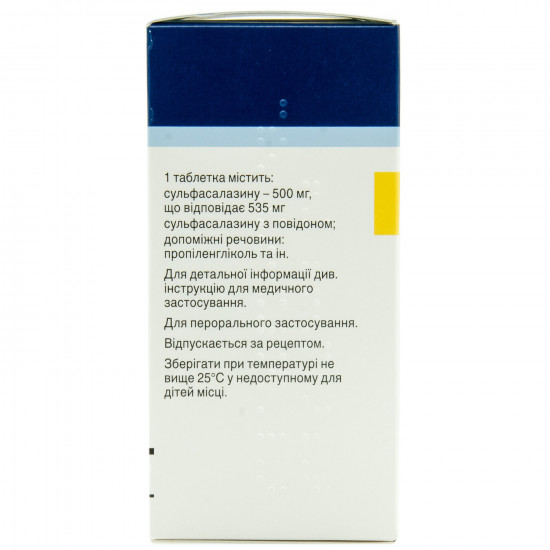




- Stock: In Stock
- Model: 184577
0% Customers recommend this product
-
5 Awesome0%
-
4 Great0%
-
3 Average0%
-
2 Bad0%
-
1 Poor0%
Reviews Over Salazopyrinum EN табс of the tab. of p/o of 500 mg No. 100
- (0)
Total Reviews (0)
click here write review to add review for this product.
Report this review.
Description
Pharmacological properties
Pharmacodynamics. in general medicament and its metabolites show immunomodulatory properties, have antibacterial effect, influence a cascade of arachidonic acid and change activity of certain enzymes. the end clinical result is decrease of the activity of inflammatory process in intestines. in a pseudorheumatism the modification of the course of the disease is observed in 1–3 months with characteristic decrease in level srb and values of other indicators of inflammation. mesalazin (me) is not considered as the reason of this effect.
Radiographic researches showed toconsiderable delay of progressing of a disease (by Larsen or Sharp's index) at patients at early stages of a disease at use of Sulfasalazinum within 2 years in comparison with placebo or hydroxychloroquine. At medicament withdrawal the positive effect authentically remains.
Pharmacokinetics
About 90% of a dose reaches a large intestine where medicament is split by bacteria on sulphapyridine (joint venture) and mesalazin (ME). These connections are also active; not split Sulfasalazinum (SASP) also shows activity at various symptoms. The Bo'lshy part of the joint venture is soaked up and exposed to hydroxylation or a glyukuronization; in urine mix of not changed and metabolizirovanny joint venture is defined. A certain quantity of ME is exposed to acetylation in a wall of a large intestine therefore with urine ATs-ME is removed mainly. SASP is removed in not changed view with bile and urine.
byIn researches of use of EN tablets did not reveal a significant difference between values of key parameters of this dosage form and equivalent dose of SASP in the form of powder; therefore data for usual tablets are given below. There are no proofs that at use of Salazopyrinum for treatment of diseases of intestines the system concentration have any impact which differs from side reactions. So, at concentration of the joint venture higher than 50 mkg/ml considerably increase risk of emergence of side reactions, especially patients with slow process have acetylations.
SASP in blood serum is reached byAt oral administration of SASP in a single dose of 3 g of the C max in 3–5 h; The delay period — 1.5 h was T ½ 5.7±0.7 h. During maintenance therapy the renal clearance of SASP was 7.3±1.7 ml/min., for the joint venture — 9.9±1.9 ml/min., and for ATs-ME — 100±20 ml/min. Free the joint venture for the first time appears in blood plasma in 4.3 h after reception of a single dose; the period of semi-absorption is 2.7 h. The t ½ by calculations makes 18 h
ME: in urine only ATs-ME (not free ME) was defined; possibly, acetylation substantially happens in a mucous membrane of a large intestine. After reception of 3 g of SASP the period of a delay was 6.1±2.3 h, levels of the general ME in blood plasma were lower than 2 mkg/ml. with urine the semi-absorption period, proceeding from these data was t ½ 6.0±3.1 h, and, is 3.0±1.5 h. The constant of renal clearance made 125 ml/min. respectively to glomerular filtration rate.
do not havecertificates that the medicament kinetics at patients with a pseudorheumatism will differ from above.
Indication
Induction and maintenance of remission in ulcer colitis; treatment of Crohn's disease in an active stage.
Treatment of a pseudorheumatism at adults in case of insufficient efficiency of NPVP.
Treatment of a juvenile polyarticulate or oligosustavny pseudorheumatism.
Use
Dose is selected individually depending on disease severity and tolerance of drug. it is necessary to swallow of tablets entirely, not to break and not to crumble.
Patients of advanced age: special cautions are absent.
Ulcer colitis
Adult
Heavy attack: 2–4 tablets of Salazopyrinum 4 times a day, are possible use in combination with steroids as a part of the mode of intensive care. At fast passing of tablets the efficiency of medicament can decrease.
Night interval between receptions should not exceed 8 h
moderately severe Attacks: 2–4 tablets 4 times a day, are possible use in combination with steroids.
Attacks of easy weight: 2 tablets 4 times a day with steroids or without them.
Maintenance therapy: after remission induction the dose is gradually reduced to 4 tablets a day. In this dose the medicament needs to be taken constantly as at the treatment termination even in several years after a bad attack the risk of a recurrence increases by 4 times.
Children. The dose is reduced in proportion to body weight. In case of a bad attack or a recurrence: 40–60 mg/kg/days
Maintenance therapy: 20–30 mg/kg/days
Crohn's disease
In Crohn's disease in the acute stage of Salazopirin-EN-tabs should be accepted according to the same scheme, as well as at attacks of ulcer colitis (see above).
PseudorheumatismAdult
At patients with a pseudorheumatism and the patients receiving NPVP for a long time reactions from a stomach are possible
therefore in case of this disease medicament Salazopirin-EN-tabs is used according to the following recommendations. Treatment needs to be begun with 1 tablet a day, gradually raising a dose on 1 tablet a day every week until the dose makes 1 tablet 4 times a day or 2 tablets 3 times a day depending on shipping and efficiency of drug. Effect of medicament is shown slowly and the significant effect can not be observed during 6 weeks. Improvement of mobility of joints has to be followed by decrease in SOE and the SRB level. Perhaps simultaneous use of NPVP and Salazopirina-EN-tabs.
Juvenile polyjoint or oligosustavny pseudorheumatism.
Children at the age of 2 years are also more senior than.
30-50 mg/kg/days, divided into 4 equal doses. Usually maximum dose makes 2000 mg/days. For reduction of possible side reaction from a GIT it is necessary to begin with reception ¼ planned a maintenance dose with the subsequent its increase for ¼ every week before achievement of a maintenance dose.
Contraindication
Hypersensitivity to Sulfasalazinum, its metabolites or to other components of medicament and also to streptocides or salicylates; porphyria; age up to 2 years.
Side effects
in general about 75% of cases of side reactions arise within the first 3 months of treatment, and more than 90% — within the first 6 months some undesirable phenomena dose-dependent and often manifestation of symptoms can be weakened, having lowered a medicament dose.
General
Sulfasalazinum is split by colibacilli to sulphapyridine and 5 aminosalicylates therefore undesirable reactions to sulfonamide or salicylate are possible. Patients with the status of slow acetylation more likely can have side reactions on sulphapyridine. The most widespread side reactions are nausea, a headache, rash, lack of appetite and the increased body temperature.
SpecificSide reactions observed in clinical trials of Sulfasalazinum are listed below by
on classes and frequency (it is very frequent (≥1/10); often (≥1/100 — 1/10); infrequently (≥1/1000 1/100)). In cases when side reaction was noted with a different frequency in clinical trials, it is specified high of frequencies about which it was reported. Additional reactions about which it was reported during the post-marketing period are also included in the following list with a frequency it "is unknown" (frequency cannot be established on the available data).
Infection and invasion: it is unknown — pseudomembranous colitis.
from the system of blood and lymphatic system: often — a leukopenia; seldom — thrombocytopenia (for more details see. Special INSTRUCTIONS); it is unknown — an agranulocytosis, aplastic anemia, hemolytic anemia, anemia with Heinz's little bodies, a prothrombinopenia, a lymphadenopathy, a macrocytosis, megaloblastny anemia, a methemoglobinemia, a neutropenia, a pancytopenia.
from the immune system: it is unknown — an anaphylaxis, a nodose polyarteritis, a serum disease.
from metabolism and food: it is unknown — loss of appetite.
Mental disturbances: often — insomnia; infrequently — a depression; it is unknown — hallucinations.
from nervous system: often — dizziness, a headache, change of flavoring feelings; seldom — spasms; it is unknown — aseptic meningitis, an ataxy, encephalopathy, peripheral neuropathy, disturbance of sense of smell.
from an organ of hearing and a labyrinth: often — a ring in ears; infrequently — vertigo.
from an organ of sight: often — an injection of a conjunctiva and a sclera.
from heart: it is unknown — allergic myocarditis, cyanosis, a pericarditis.
from the vascular system: infrequently — a vasculitis.
from the respiratory system, bodies of a thorax and mediastinum: often — cough; infrequently — dispnoe, it is unknown — a fibrous alveolitis, eosinophilic infiltration, an interstitial disease of lungs.
from a GIT: very often — indigestions, nausea; often — an abdominal pain, diarrhea, vomiting, stomatitis; it is unknown — exacerbation of nonspecific ulcer colitis, pancreatitis, parotitis.
from a liver: it is unknown — a liver failure, lightning hepatitis, hepatitis (for more details see. Special INSTRUCTIONS).
from skin and hypodermic cellulose: often — an itching; infrequently — an alopecia, a small tortoiseshell; it is unknown — an epidermal necrolysis (Lyell's disease), Stephens's syndrome — Johnson, medicamentous rash with an eosinophilia and system symptoms (DRESS), sharp generalized exanthematous pustulez, an erythema, a dieback, exfoliative dermatitis, periorbital hypostasis, red flat deprive, a photosensitization.
from the musculoskeletal system and connective tissue: often — an arthralgia; it is unknown — a system lupus erythematosus.
from an urinary system: often — a proteinuria; it is unknown — a nephrotic syndrome, interstitial nephrite, a crystalluria (for more details see. Special INSTRUCTIONS), hamaturia.
from a reproductive system and mammary glands: a reversible oligospermatism (for more details see. Special INSTRUCTIONS).
General state and disturbances connected with a medicament route of administration: often — fever; seldom — a face edema; it is unknown — coloring of skin and liquids of an organism in yellow color.
Research: infrequently — increase in activity of enzymes of a liver; it is unknown — induction of autoantibodies.
Special instructions
Prior to therapy and within the first 3 months of treatment at all patients should control indicators of the developed blood test (including a leukocytic formula), definition of indicators of function of a liver and kidneys (including the analysis of urine). further these indicators control according to clinical indications. patients should be warned about need to see immediately a doctor at emergence of such clinical signs as a sore throat, fever, an indisposition, pallor, a purpura, jaundice or a sudden nonspecific disease during treatment of Sulfasalazinum, can indicate it myelosuppression, hemolysis or hepatotoxicity. with these signs the treatment by Sulfasalazinum should be stopped before obtaining results of blood test.
should not appoint Sulfasalazinum the patient with an abnormal liver function or kidneys or with pathological changes of blood, except for cases when the potential advantage exceeds risk.
should appoint Sulfasalazinum bywith care the patient with a heavy allergy or OH.
Use of medicament at treatment of children with a system form of a juvenile pseudorheumatism often causes the reactions similar to a serum disease therefore these patients are not recommended to appoint Sulfasalazinum.
As sulfazalazin development of hemolytic anemia can cause, it is necessary to apply with care it at patients with deficit glyukozo-6-fosfatdegidrogenazy.
Sulfasalazinum at oral administration slows down absorption and metabolism of folic acid that can entail its deficit and lead to serious violations from blood (for example to a macrocytosis and a pancytopenia), the condition of the patient can be normalized at use of folic or foliniyevy acid (leykovorin).
As Sulfasalazinum causes a crystalluria and formation of concrements in kidneys, during treatment it is necessary to use enough liquid.
At the men treated by Sulfasalazinum the oligospermatism and infertility is possible. After the therapy termination by Sulfasalazinum these effects disappear within 2–3 months
Period of pregnancy and feeding by a breast.
Pregnancy
On the published data on use of Sulfasalazinum for pregnant is not present certificates on risks of teratogenic influence. Probability of negative impact on a fruit at use of Sulfasalazinum during pregnancy low. At oral administration Sulfasalazinum oppresses absorption and metabolism of folic acid and can result in deficiency of folic acid. As the negative impact completely cannot be excluded, during pregnancy Sulfasalazinum is appointed only in urgent cases.
Feeding by a breastSulfasalazinum and sulphapyridine in small amounts are defined by
in breast milk therefore medicament should be used with care during feeding by a breast, especially in case of premature newborns and deficit glyukozo-6-fosfatdegidrogenazy. The decision on the feeding termination by a breast or medicament withdrawal is accepted by the attending physician on the basis of careful assessment of a ratio advantage for mother/risk for the child.
Children. Drug is contraindicated to children under 2 years. Use of medicament at treatment of children with a system form of a juvenile pseudorheumatism often causes the reactions similar to a serum disease therefore these patients are not recommended to appoint Sulfasalazinum.
Influence on ability to run vehicles or to work with other mechanisms. Influence of Sulfasalazinum on speed of response at control of vehicles or work with other mechanisms systematically was not estimated.
toInteraction
byIt was reported about decrease in absorption of digoxin that resulted in subtherapeutic concentration of the last in blood serum, at its simultaneous use with an oral form of Sulfasalazinum.
On chemical properties streptocides have a certain similarity to some oral hypoglycemic drugs. At the patients accepting streptocides the hypoglycemia was observed. It is necessary to control carefully a condition of the patients accepting Sulfasalazinum and hypoglycemic means.
As Sulfasalazinum oppresses thiopurinemethyltransferases, at simultaneous use of peroral Salazopyrinum and thiopurine-6-Mercaptopurinum or its pro-medicaments (Azathioprinum) the oppression of function of marrow and development of a leukopenia is possible.
Simultaneous use of Sulfasalazinum and a methotrexate for patients with a pseudorheumatism does not changepharmacokinetic characteristics of drugs. However it was reported about increase in frequency of side reactions from a GIT, in particular nausea.
Overdose
in the absence of hypersensitivity acute toxicity of medicament at oral administration low. there is no specific antidote, it is necessary to carry out the supporting treatment.
Storage conditions
At a temperature not above 25 °C.
Specifications
| Characteristics | |
| Active ingredients | Sulfasalazinum |
| Amount of active ingredient | 500 mg |
| Applicant | Pfizer |
| Code of automatic telephone exchange | A07EC01 Sulfasalazinum |
| Interaction with food | It doesn't matter |
| Light sensitivity | Not sensitive |
| Market status | Original |
| Origin | Chemical |
| Prescription status | According to the prescription |
| Primary packing | bottle |
| Producer | RETSIFARM UPPSALA AB. |
| Quantity in packing | 100 tablets |
| Release form | tablets for internal use |
| Route of administration | Oral |
| Sign | Import |
| Storage temperature | from 5 °C to 25 °C |
| Trade name | Salazopyrinum |










